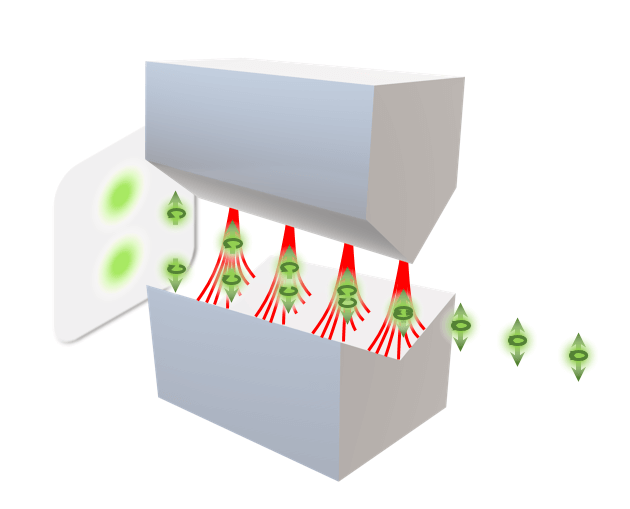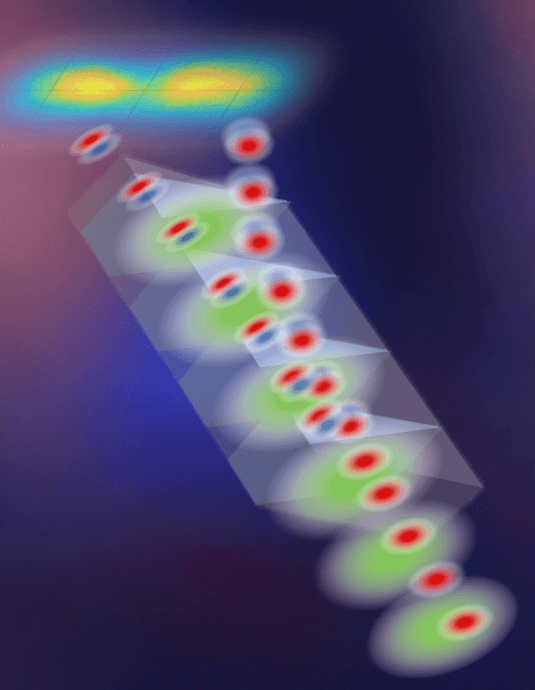In a recent experiment conducted at Tel Aviv University and published in the prestigious journal Nature Photonics, the researchers showed that it is also possible to split and bend the path of light beams, by using an additional light beam and a non-linear crystal

Light rays advance in a uniform medium such as air or glass in straight lines, but on the other hand, the path of charged particles such as electrons can be curved by applying an electric or magnetic field. In a recent experiment conducted at Tel Aviv University and published in the prestigious journal Nature Photonics, the researchers showed that it is also possible to split and bend the path of light beams, by using an additional light beam and a non-linear crystal.
The team of researchers from the Faculty of Engineering and the School of Physics of Tel Aviv University includes the doctoral students Ofir Isram (who led the experiment) and Aviv Karneali, Dr. Steven Jackel, Dr. Giuseppe Di Domenico, and Dr. Sivan Trachtenberg-Mills, under Guided by Prof. Adi Aryeh, in charge of the Marco and Lucy Shaul Chair.
The experiment carried out is based on an analogy in the optical field to one of the key experiments of quantum theory, the Stern-Gerlach experiment which was published exactly 100 years ago, in 1922. The German researchers Otto Stern and Walter Gerlach sent silver atoms through a spatially varying magnetic field, and noticed that as a result Splitting of the beam of atoms: half of the atoms deviated in one direction, and the other half in the opposite direction. This is because silver's valence electrons have a property called spin, which also determines the magnetic moment of each electron. The external magnetic field exerts a force on the electron, which depends on the direction of the magnetic moment of that electron. In the experiment, it became clear that the measured spin value can have only two possible values (called "up" and "down"), therefore the beam of atoms splits into only two angles.
Today, 100 years after the original experiment, researchers from Tel Aviv University performed a parallel experiment in optics, in which light rays were split using a non-linear interaction (an interaction in which light rays can influence each other).
As part of the experiment, the researchers used non-linear optical crystals. According to them, these crystals are often used to perform frequency conversions - that is, a laser beam of a certain wavelength (color) will become a beam of a different wavelength.

Prof. Adi Aryeh explains: "In this experiment, we sent 3 light beams of different wavelengths to a non-linear crystal, which for convenience we will symbolically mark as blue, green and red beams. The green beam is much stronger than the other beams, and through the non-linear process, it enables the conversion of energy from the blue beam to red or vice versa. In the experiment carried out, a wide green beam was sent, its maximum intensity in the center, and it decreases to zero at the edges of the beam. This creates an interaction that changes in space - a strong interaction in the center of the beam, and a weak interaction at the edge.
Prof. Aryeh adds that "this beam plays a role analogous to the spatially varying magnetic field in the original Stern-Gerlach experiment. If we send a blue beam into the area illuminated by the reflections of the green beam, we will get a split into two beams moving at different angles, each of which now has blue light and red light. In one of the beams the blue light and the red light have the same phase (phase) and it moves to the right and in the other beam they are in the opposite direction and it moves to the left. These two beams are the spin analog of the electron in the original Stern Gerlach experiment. It is also possible to increase or decrease the splitting angle by increasing or decreasing the intensity of the green laser. On the other hand, when a combined beam of blue and red was inserted, no splitting could be seen - the beam deviated in only one direction, depending on the occurrence between the inserted colors. This experiment is analogous to the case where silver atoms with only "up" or "down" spin are inserted in the Stern Gerlach experiment."
In conclusion, the researchers explain that spatial splitting of wavelengths is nothing new. A prism, for example, allows a spatial splitting of wavelengths into different angles, but this splitting is permanent and separates each color in one direction. In the experiment demonstrated as part of this research, the splitting makes it possible to use a combination of wavelengths, depending on the occurrence between them, and to control the splitting angle by an additional light beam. This phenomenon has potential applications in the fields of signal processing and optical communication, quantum communication, quantum computing, precision sensing, and more. The researchers believe that the experiment will be the starting point for further experiments that take advantage of the parallel between systems of electrons in a magnetic field and optical systems.
More of the topic in Hayadan:
- The Technion researcher applied the theory of games in the guidance of missiles
- An explanation for a long-standing mystery in hydrogen production
- Israeli researchers have deciphered a new mechanism in the process related to the production of hydrogen using solar energy
- Creation and control of accelerating laser beams (Airy Beams) using nonlinear photonic crystals
- A researcher managed to miniaturize hybrid chips without compromising their efficiency and accuracy

One response
In 1995 I studied it at the Technion - photorefractive materials. It was dealt with by 2 researchers in electrical engineering and in physics, probably a few more. Fraction - breaking.